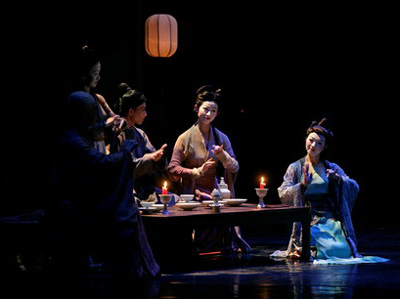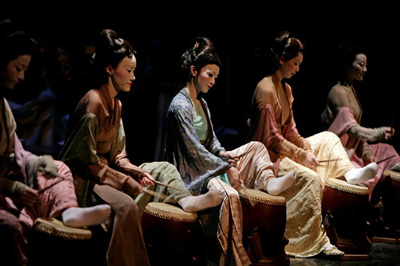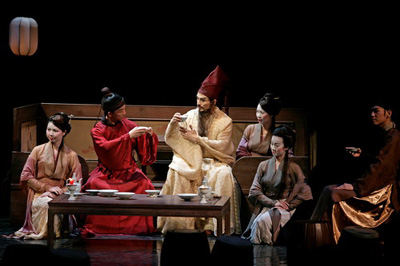A Taiwan musicologist is rescuing two of China's most ancient musical arts, Nanyin music and Liyuan Opera, and combining the "musical fossils" into a graceful new form.
Nanyin music originated as the gentle sound of the ancient Chinese imperial court around 1,000 years ago, but the art form is dying.
A Taiwan musicologist recognized the need to revive it; her company performed Nanyin music and Liyuan (Pear Orchard) Opera in the Forbidden City two weeks ago and last week in Shanghai.
The combination represents a striking new theatrical form that - if it catches on - may help preserve both Nanyin music and Liyuan Opera from extinction.
"I'm so grateful that I finally managed to bring this missing Nanyin music child back to his family," says overjoyed Chen Mei-o, founder and artistic director of the Taipei-based Han Tang Yue Fu Music Ensemble.
For the first time in its 588-year history, the Forbidden City in Beijing hosted a performance by a private arts company, Han Tang Yue Fu. The ensemble revived scenes from the Tang Dynasty (618-907 AD) painting The Feast of Han Xizai, including the arts of tea and flower arranging.
Chen was in Shanghai last Friday to perform at the Radisson Hotel Pudong Century Park's Mid-Autumn Festival party. For an hour, her troupe performed its repertoire to a curious audience - most of its members had never heard about Nanyin before. The performance featured five dancers, six musicians, and Chen herself as a backstage vocalist.
Nanyin music and Liyuan Opera both originated in what is now Fujian Province and are almost extinct. Nanyin is musical performance only and Chen decided it would be more appealing if combined with Liyuan Opera performed without words - she adds separate vocals.
"I found it very interesting," says audience member Frenchman Pierre Baubry. "At first I thought it was very much like Japanese geisha performing. However, later on I found it more subtle and elegant, with stories to be told in each movement of the actresses."
Wu Jun, another member of the audience, says: "The gestures of the dancers remind me of women in old Chinese paintings."

The dancers transformed themselves into standard Chinese beauties in the ancient times: long eye lashes, willow leaf-shaped eyebrows, and cherry-like little mouths.
For most of the time they did not display emotion, and there were few props used, only a delicate fan in the hand or a flower in the hair.
The first piece "Yan Ge Xing" ("Sumptuous Feasting Song") extols the graceful, seductive walking and gestures of three xiao dan, or maidens. The second one "Zhan Hua Ji" ("The Jeweled Hairpin") describes the melancholy of a lonely da dan, or mature lady imprisoned in her marital chambers.
And the symphony "Man Tang Chun" ("Hall Aburst with Springtime") features traditional Chinese musical instruments such as pipa or lute and percussion. It expresses the spirit of respect and harmony in ancient ritual music.
All the programs of Han Tang Yue Fu are written, choreographed, and directed by Chen, who started the study and research of Nanyin 35 years ago. Nanyin music is said to be the "living fossil" of ancient Chinese tunes.
Born in Kaohsiung and brought up in Taipei, Chen closely followed traditional Chinese opera in her childhood. Her father was a master erhu (two-stringed fiddle) player and she was brought up by her aunt, a performer of the popular puppet opera in Taiwan.
Having witnessed the eclipse of traditional opera in Taiwan in the 1960s, Chen became a radio broadcaster to introduce folk music when she was 16.
"One day I received a letter from a listener, asking me to talk more about Nanyin, the oldest Chinese music form known to exist," she recalls. "I tried to find and arrange interviews with some of the Nanyin experts in Taiwan. I was fascinated and fell in love with the beautiful melodies immediately."
The young lady wanted to learn more. However, at that time, she couldn't find any writings about the music form, nor there was a school teaching it. With financial support from her brother, the resolute 16-year-old undertook a 10-year research on Nanyin. She visited almost all the living Nanyin artists she could find in Taiwan and Southeast Asia, and visited universities and colleges with Chinese history and culture studies all over the world, including Harvard, Oxford and Cambridge.

"The more I learned about Nanyin, the more I wanted to revive it and bring it back into fashion," Chen says.
In 1983, she established Han Tang Yue Fu in Taipei, with the aim of cultivating more talents of the ancient music while continuing her academic study. She introduced a new performance art, which combines Nanyin with the equally antique tradition of Liyuan Opera.
"To be honest, I didn't realize it would be such a perfect combination of vision and acoustics at first," she says. "I was told by many people that they consider it not an ancient art form but a quite avant-garde one. My idea comes from the tradition, and I'm trying to create a tradition."
In the past 20 years, the self-taught artist has taken her ensemble to Europe, the United States, and Australia as well as Japan, South Korea, and the Chinese mainland.
In her 50s, Chen says she doesn't consider Nanyin as a part of her life, but "all of my life."
"I have devoted all my passion, energy, and love to Nanyin," she says. "It has such a power that every time I listen to Nanyin, I am lost in the world of music and forget about everything around me. It brings me peace deep in the heart."
(Shanghai Daily September 27, 2007)




